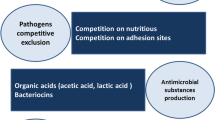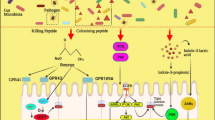Abstract
The intestinal environment accommodates a wide range of contents ranging from harmless beneficial dietary and microbial flora to harmful pathogenic bacteria. This has resulted in the development of highly adapted epithelial cells lining the intestine. This adaptation involves the potential of crypt cells to proliferate and to constantly replace villous cells that are lost due to maturity or death. As a result, the normal intestinal epithelial integrity and functions are maintained. This phenomenon is eminent in intestinal defense whereby the intestinal epithelial cells serve as a physical barrier against luminal agents. The protection against agents in the gut lumen can only be effective if the epithelium is intact. Restitution of the damaged epithelium is therefore crucial in this type of defense.
Similar content being viewed by others
Abbreviations
- Hsp(s):
-
heat-shock protein(s)
- IL:
-
interleukin
References
Andoh A., Fujiyama Y., Hata K., Araki Y., Takaya H., Shimada M., Bamba T.: Counter-regulatory effect of sodium butyrate on tumuor necrosis factor-α (TNF-α)-induced complement C3 and factor B biosynthesis in human intestinal epithelial cells. Clin.Exp.Immunol.118, 23–29 (1999).
Asanuma N., Kawato M., Hino T.: Presence of Butyrivibrio fibrisolvens in the digestive tract of dogs and cats, and its contribution to butyrate production. J.Gen.Appl.Microbiol.47, 313–319 (2001).
Awane M., Andres P.G., Li D.J., Reinecker H.C.: NF-κB-inducing kinase is a common mediator of IL-17, TNF-α-, and IL-1β-induced chemokine promoter activation in intestinal epithelial cells. J.Immunol.162, 5337–5344 (1999).
Bernard J.A., Warwick G.: Butyrate rapidly induces growth inhibition and differentiation in HT-29 cells. Cell Growth Differ. 4, 495–501 (1993).
Cahill C.M., Waterman W.R., Xie Y., Auron P.E., Calderwood S.K.: Transcriptional repression of the proinflammatory 1β gene by heat shock factor 1. J.Biol.Chem.271, 24874–24879 (1996).
Castagliuolo I., Riegler M.F., Valenick L., Lamont J.T., Pothoulakis C.: Saccharomyces boulardii protease inhibits the effects of Clostridium difficile toxins A and B in human colonic mucosa. Infect.Immun.67, 302–307 (1999).
Chu E.K., Ribeiro S.P., Slutsky A.S.: Heat stress increases survival rates in lipopolysaccharide-stimulated rats. Crit.Care Med.25, 1727–1732 (1997).
Coconnier M.-H., Bernet-Camard M.F., Servin A.L.: How intestinal epithelial cell differentiation inhibits the cell-entry of Yersinia pseudotuberculosis in colon carcinoma Caco-2 cell line in culture. Differentiation58, 87–94 (1994).
Coconnier M.-H., Lievin V., Lorrot M., Servin A.L.: Antagonistic activity of Lactobacillus acidophilus LB against intracellular Salmonella enterica serovar typhimurium infecting human enterocyte-like Caco-2/TC-7 cells. Appl.Environ.Microbiol.66, 1152–1157 (2000).
Cummings J.H., Branch W.J.: Fermentation and production of short chain fatty acids in human large intestine, pp. 131–152 in G.B. Vahouny, D. Kritchevesky (Eds): Dietary Fiber: Basic and Clinical Aspects. Plenum Press, New York 1990.
Cummings J.H., Pomare E.W., Branch W.J., Naylor C.P.E., MacFarlane G.T.: Short-chain fatty acids in human large intestine, portal, hepatic and venous blood. Gut28, 1221–1227 (1987).
Elewaut D., DiDonato J.A., Kim J.M., Truong F., Eckmann L., Kagnoff M.F.: NF-κB is a central regulator of the intestinal epithelial cell innate immune response induced by infection with enteroinvasive bacteria. J.Immunol.163, 1457–1466 (1999).
Fajdiga S., Koninkx J.F.J.G., Tooten P.C.J., Marinšek-Logar R.: Interference of Salmonella enteritidis and Lactobacillus spp. with IL-8 levels and transepithelial electrical resistance of enterocyte-like Caco-2 cells. Folia Microbiol.51, 286–272 (2006).
Frankel W.L., Zhang W., Singh A., Klurfeld D.M., Don S., Sakata T., Modlin I., Rombeau J.L.: Mediation of the trophic effects of short-chain fatty acids on the rat jejunum and colon. Gastroenterology106, 375–380 (1994).
Fukushima Y., Kawata Y., Hara H., Terada A., Mitsuoka T.: Effect of a probiotic formula on intestinal immunoglobulin A production in healthy children. Internat.J.Food Microbiol.42, 39–44 (1998).
Gionchetti P., Rizello F., Venturi A., Brigidi P., Matteuzzi D., Bazzocchi G., Poggiolo G., Miglioli M., Campieri M.: Oral bacteriotherapy as maintenance treatment in patients with chronic pouchitis: a double-blind placebo-controlled trial. Gastroenterology119, 305–309 (2000a).
Gionchetti P., Rizzello F., Venturi A., Campieri M.: Probiotics in infective diarrhea and inflammatory bowel diseases. J.Gastroenterol.Hepatol.15, 489–493 (2000b).
Goldin B.R., Gorbach S.L., Saxelin M., Barakat S., Gualtieri L., Salminen S.: Survival of Lactobacillus species (strain GG) in human gastrointestinal tract. Dig.Dis.Sci.37, 121–128 (1992).
Hobbie S., Chen L.M., Davis R.J., Galan J.E.: Involvement of mitogen-activated protein kinase pathways in the nuclear responses and cytokine production induced by Salmonella typhimurium in cultured intestinal epithelial cells. J.Immunol.159, 5550–5559 (1997).
Horosová K., Bujňáková D., Kmeť V.: Effect of lactobacilli on E. coli adhesion to Caco-2 cells in vitro. Folia Microbiol.51, 281–282 (2006).
Huang N., Katz J.P., Martin D.R., Wu G.D.: Inhibition of IL-8 gene expression in Caco-2 cells by compounds which induce histone hyperacetylation. Cytokine9, 27–36 (1997).
Hudcovic T., Štěpánková R., Kozáková H., Hrnčíř T., Tlaskalová-Hogenová H.: Effects of monoclonization with Escherichia coli strains O6K13 and Nissle 1917 on the development of experimentally induced acute and chronic intestinal inflammation in germ-free immunocompetent and immunodeficient mice. Folia Microbiol.52, 618–626 (2007).
Kokešová A., Frolová L., Kverka M., Sokol D., Rossmann P., Bártová J., Tlaskalová-Hogenová H.: Oral administration of probiotic bacteria (E. coli Nissle, E. coli O83, Lactobacillus casei) influences the severity of dextran-sodium-sulfate-induced colitis in BALB/c mice. Folia Microbiol.51, 478–484 (2006).
Kopečný J., Zorec M., Mrázek J., Kobayashi Y., Marinšek-Logar R.: Butyrivibrio hungatei sp.nov. and Pseudobutyrivibrio xylanivorans sp.nov., butyrate-producing bacteria from the rumen. Internat.J.Syst.Evol.Microbiol.53, 201–209 (2003).
Koninkx J.F.J.G.: Enterocyte-like Caco-2 cells as a tool to study lectin interaction, pp. 81–101 in A. Pusztai, S. Bardocz (Eds): Lectins: Biomedical Perpectives. Taylor and Francis, London 1995.
Koninkx J.F.J.G., Hendriks H.G.C.J.M., van Rossum J.M.A., van den Ingh T.S.G.A.M., Mouwen J.M.V.M.: Interaction of legume lectins with the cellular metabolism of differentiated Caco-2 cells. Gastroenterology102, 1516–1523 (1992).
Koyasu S., Nishida E., Kadowaki T., Matsuzaki F., Iida K., Harada F., Kasuga M., Sakai H., Yahara I.: Two mammalian heat shock proteins, Hsp90 and Hsp100, are actin binding proteins. Proc.Nat.Acad.Sci.USA83, 8054–8058 (1986).
Liang P., MacRae T.H.: Molecular chaperones and the cytoskeleton. J.Cell Sci.110, 1431–1440 (1997).
Mackie R.I., Sghir A., Gaskins H.R.: Developmental microbial ecology of the neonatal gastrointestinal tract. Am.J.Clin.Nutr.69, 1035S–1045S (1999).
Malago J.J., Koninkx J.F.J.G., van Dijk J.E.: The heat shock response and cytoprotection of the intestinal epithelium. Cell. Stress & Chaperones7, 191–199 (2002).
Malago J.J., Koninkx J.F.J.G., Ovelgönne H.H., van Asten F.J.A.M., Swennenhuis J.F., van Dijk J.E.: Expression levels of heat shock proteins in enterocyte-like Caco-2 cells after exposure to Salmonella enteritidis. Cell Stress & Chaperones8, 194–203 (2003).
Malago J.J., Koninkx J.F.J.G., Tooten P.C.J., van Liere E.A., van Dijk J.E.: Anti-inflammatory properties of heat shock protein 70 and butyrate on Salmonella-induced interleukin-8 secretion in enterocyte-like Caco-2 cells. Clin.Exp.Immunol.141, 62–71 (2005).
Malin M., Suomalainen H., Saxelin M., Isolauri E.: Promotion of IgA immune response in patients with Crohn’s disease by oral bacteriotherapy with Lactobacillus GG. Ann.Nutr.Metab.40, 137–145 (1996).
Musch M.W., Sugi K., Straus D., Chang E.B.: Heat shock protein 72 protects against oxidant-induced injury of barrier function of human colonic epithelial Caco-2/bbe cells. Gastroenterology117, 115–122 (1999).
Nemeth E., Fajdiga S., Malago J., Koninkx J., Tooten P, van Dijk J.: Inhibition of Salmonella-induced IL-8 synthesis and expression of Hsp70 in enterocyte-like Caco-2 cells after exposure to non-starter lactobacilli. Internat.J.Food Microbiol.112, 266–274 (2006).
Nurmi E., Rantale M.: New aspects of Salmonella infection in broiler production. Nature241, 210–211 (1973).
Ovelgönne J.H., Koninkx J.F.J.G., Pusztai A., Bardocz S., Kok W., Ewen S.W.B., Hendriks H.G.C.J.M., van Dijk J.E.: Decreased level of heat shock proteins in gut epithelial cells after exposure to plant lectins. Gut46, 679–687 (2000).
Paton A.W., Morona R., Paton J.C.: Designer probiotics for prevention of enteric infections. Nature Rev.Microbiol.4, 193–200 (2006).
Perdigon G., de Macias M.E., Alvarez S., Oliver G., de Ruiz Halgado A.A.: Effect of perorally administered lactobacilli on macrophage activation in mice. Infect.Immun.53, 404–410 (1986).
Pinto M., Robine-Leon S., Appay M.D., Kedinger M., Triadou N., Dussaulx E., Lacroix B., Simon-Assmann P., Haffen K., Fogh J., Zweibaum A.: Enterocyte-like differentiation and polarization of the human colon carcinoma cell line Caco-2 in culture. Biol.Cell47, 323–330 (1883).
Pusztai A., Grant G., Spencer R.J., Duguid T.J., Brown D.S., Ewen S.W.B., Peumans W.J., van Damme E.J.M., Bardocz S.: Kidney bean lectin induced Escherichia coli overgrowth in the small intestine is blocked by GNA, a mannose-specific lectin. J.Appl.Bacteriol.75, 360–368 (1993).
Pusztai A., Ewen S.W.B., Grant G., Peumans W.J., van Damme E.J.M., Coates M.E., Bardocz S.: Lectins and also bacteria modify the glycosylation of gut surface receptors in the rat. Glycoconjugate J.12, 22–35 (1995).
Ren H., Musch M.W., Kojima K., Boone D., Ma A.: Short-chain fatty acids induce intestinal epithelial heat shock protein 25 expression in rats and IEC 18 cells. Gastroenterology121, 631–639 (2001).
Rousseaux C., Thuru X., Gelot A., Barnich N., Neut C., Dubuqouy L., Dubuquoy C., Merour E., Geboes K., Chamaillard M., Ouwehand A., Leyer G., Carcano D., Colombel J.F., Ardid D., Desreumaux P.: Lactobacillus acidophilus modulates intestinal pain and induces opioid and cannabinoid receptors. Nature Med.13, 35–37 (2007).
Sugita T., Togawa M.: Efficacy of lactobacillus preparation biolactis powder in children with rotavirus enteritis. Jap.J.Ped.47, 2755–2762 (1994).
Trebichavský I., Šplíchal I.: Probiotics manipulate host cytokine response and induce antimicrobial peptides. Folia Microbiol.51, 507–510 (2006).
Treem W.R., Ahsan N., Shoup M., Hyams J.: Fecal short-chain fatty acids in children with inflammatory bowel disease. J.Pediatr.Gastroenterol.Nutr.18, 159–164 (1994).
Yoo C., Lee S., Lee C., Kim Y.W., Han S.K., Shim Y.: Anti-inflammatory effect of heat shock protein induction is related to stabilization of IκBα through preventing IκB kinase activation in respiratory epithelial cells. J.Immunol.164, 5416–5423 (2000).
Author information
Authors and Affiliations
Corresponding author
Rights and permissions
About this article
Cite this article
Koninkx, J.F.J.G., Malago, J.J. The protective potency of probiotic bacteria and their microbial products against enteric infections-review. Folia Microbiol 53, 189–194 (2008). https://doi.org/10.1007/s12223-008-0023-0
Received:
Revised:
Published:
Issue Date:
DOI: https://doi.org/10.1007/s12223-008-0023-0




